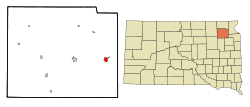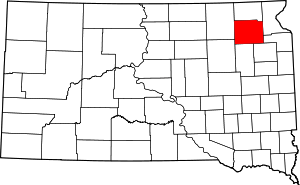Waubay, South Dakota
Waubay is a city in Day County, South Dakota, United States. The population was 576 at the 2010 census.
Waubay, South Dakota | |
|---|---|
 Location in Day County and the state of South Dakota | |
| Coordinates: 45°19′59″N 97°18′15″W | |
| Country | United States |
| State | South Dakota |
| County | Day |
| Incorporated | 1895[1] |
| Area | |
| • Total | 1.45 sq mi (3.77 km2) |
| • Land | 1.45 sq mi (3.77 km2) |
| • Water | 0.00 sq mi (0.00 km2) |
| Elevation | 1,818 ft (554 m) |
| Population | |
| • Total | 576 |
| • Estimate (2019)[4] | 560 |
| • Density | 385.14/sq mi (148.69/km2) |
| Time zone | UTC-6 (Central (CST)) |
| • Summer (DST) | UTC-5 (CDT) |
| ZIP code | 57273 |
| Area code(s) | 605 |
| FIPS code | 46-69340[5] |
| GNIS feature ID | 1265711[6] |
Waubay had its start in the early 1880s when the railroad was extended to that point.[7]
The school district is Waubay Public 18-3. The local newspaper is the oldest business in town called the Waubay Clipper.
Geography
Waubay is located at 45°19′59″N 97°18′15″W (45.333174, -97.304192).[8]
According to the United States Census Bureau, the city has a total area of 1.46 square miles (3.78 km2), all land.[9]
Demographics
| Historical population | |||
|---|---|---|---|
| Census | Pop. | %± | |
| 1900 | 430 | — | |
| 1910 | 803 | 86.7% | |
| 1920 | 979 | 21.9% | |
| 1930 | 903 | −7.8% | |
| 1940 | 882 | −2.3% | |
| 1950 | 879 | −0.3% | |
| 1960 | 851 | −3.2% | |
| 1970 | 696 | −18.2% | |
| 1980 | 675 | −3.0% | |
| 1990 | 647 | −4.1% | |
| 2000 | 662 | 2.3% | |
| 2010 | 576 | −13.0% | |
| Est. 2019 | 560 | [4] | −2.8% |
| U.S. Decennial Census[10] | |||
2010 census
As of the census[3] of 2010, there were 576 people, 242 households, and 148 families residing in the city. The population density was 394.5 inhabitants per square mile (152.3/km2). There were 374 housing units at an average density of 256.2 per square mile (98.9/km2). The racial makeup of the city was 59.9% White, 36.5% Native American, 0.3% Asian, and 3.3% from two or more races. Hispanic or Latino of any race were 2.3% of the population.
There were 242 households of which 30.2% had children under the age of 18 living with them, 38.0% were married couples living together, 16.5% had a female householder with no husband present, 6.6% had a male householder with no wife present, and 38.8% were non-families. 34.7% of all households were made up of individuals and 17.4% had someone living alone who was 65 years of age or older. The average household size was 2.38 and the average family size was 3.05.
The median age in the city was 43.1 years. 26.6% of residents were under the age of 18; 6.6% were between the ages of 18 and 24; 20.1% were from 25 to 44; 26.1% were from 45 to 64; and 20.5% were 65 years of age or older. The gender makeup of the city was 49.0% male and 51.0% female.
2000 census
As of the census[5] of 2000, there were 662 people, 275 households, and 168 families residing in the city. The population density was 454.0 people per square mile (175.1/km²). There were 389 housing units at an average density of 266.8 per square mile (102.9/km²). The racial makeup of the city was 71.45% White, 25.23% Native American, 0.15% Pacific Islander, and 3.17% from two or more races. Hispanic or Latino of any race were 1.06% of the population.
There were 275 households out of which 26.2% had children under the age of 18 living with them, 44.7% were married couples living together, 11.6% had a female householder with no husband present, and 38.9% were non-families. 34.5% of all households were made up of individuals and 19.6% had someone living alone who was 65 years of age or older. The average household size was 2.38 and the average family size was 3.06.
In the city, the population was spread out with 28.4% under the age of 18, 5.4% from 18 to 24, 19.6% from 25 to 44, 22.4% from 45 to 64, and 24.2% who were 65 years of age or older. The median age was 43 years. For every 100 females, there were 88.6 males. For every 100 females age 18 and over, there were 78.9 males.
The median income for a household in the city was $25,395, and the median income for a family was $30,833. Males had a median income of $26,528 versus $18,281 for females. The per capita income for the city was $15,746. About 19.5% of families and 27.6% of the population were below the poverty line, including 37.7% of those under age 18 and 21.1% of those age 65 or over.
References
- "SD Towns" (PDF). South Dakota State Historical Society. Retrieved 2010-02-17.
- "2019 U.S. Gazetteer Files". United States Census Bureau. Retrieved July 30, 2020.
- "U.S. Census website". United States Census Bureau. Retrieved 2012-06-21.
- "Population and Housing Unit Estimates". United States Census Bureau. May 24, 2020. Retrieved May 27, 2020.
- "U.S. Census website". United States Census Bureau. Retrieved 2008-01-31.
- "US Board on Geographic Names". United States Geological Survey. 2007-10-25. Retrieved 2008-01-31.
- Federal Writers' Project (1940). South Dakota place-names, v.1-3. University of South Dakota. p. 68.
- "US Gazetteer files: 2010, 2000, and 1990". United States Census Bureau. 2011-02-12. Retrieved 2011-04-23.
- "US Gazetteer files 2010". United States Census Bureau. Retrieved 2012-06-21.
- United States Census Bureau. "Census of Population and Housing". Retrieved June 23, 2016.
